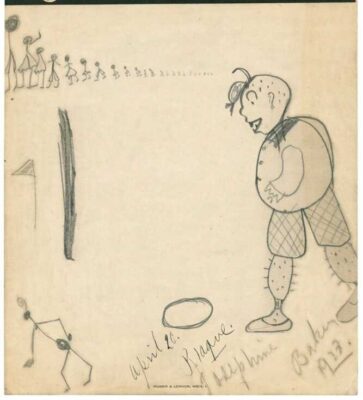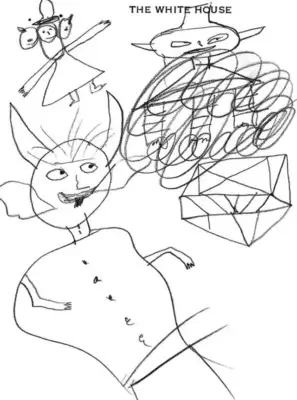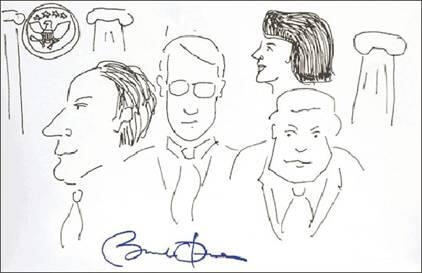Art Traveler
The joy of doodling: Pencil and paper, please!
I am doing what was frowned on in grade school as of this writing. It was seen as a form of daydreaming, boredom, or just wasting time. I was doodling. Little did I know that doodling would be an important, influential exercise that would define me for the rest of my life. It has indirectly guided the career path as an artist and designer that I enjoy today.

No, I don’t doodle as a form of income. Well, maybe. Doodling, for me, is a means to an end. It is a way of life for most of us in the creative field. It is an indispensable exercise that has led to some of the most incredible art, design, architecture, film, and photography the world has ever known. I would even go as far as to say that the exercise of doodling expands into a host of other fields and disciplines that have significantly contributed to humankind.
Even though I work with a digital tablet, there is no comparison to the tactile nature of pencil and paper. So, for the purpose of this article, we are talking about this subject using a pencil, pen or brush, and actual paper.
Like meditation, exercise, or diet, doodling can be more than just passing the time. Researchers have found that there are actually benefits to doodling.
What is it?
Doodling is an art that you do without even thinking. Usually, it accompanies a wandering mind. Of course, some doodles are better than others. After all, not everyone has a talent for drawing. However, no one has to be a great artist when doodling. Doodling is for everyone to enjoy.
There are many reasons we doodle. Sometimes it’s unconscious, and at times, it’s a purposeful, intentional way of constructing something physically or mentally. It is said to be an expression of your inner self, and a peek into your subconscious mind. For an artist, doodling is not only fun; it is necessary to allow you to create visually what your mind is releasing with your hand being the physical tool as a means to an end.
Some of the benefits of doodling
The act of doodling actually has a few benefits to brag about. Some of them are as follows:
Relaxation. Coping with life, in general, can be a challenge. The problems associated with stress are no joke. According to the Centers for Disease Control and Prevention (CDC), stress can contribute to issues such as feelings of fear, anger, sadness, worry, numbness, or frustration. Also, changes in appetite, energy, desires, and interests. Physical issues include headaches, body pains, stomach problems, skin rashes, and worsening chronic health problems. Increased use of tobacco, alcohol, and even drugs. Meanwhile, scientists, artists, and teachers agree that doodling soothes our feelings of distress.

One 2016 study of 39 university students, staff, and faculty found that after making art, 75 percent of participants had lower levels of cortisol (stress hormones) in their saliva. It didn’t matter whether the art was representational or “mere” scribbling. (Karen Sosnoski, Ph.D.)
It did not matter that some participants were artists and others were not. Art-making or doodling as a stress reliever was equally effective. The researchers also concluded that “art-making could be a way to regulate mood and addictive behaviors.
Enhanced Memory. A memory test was conducted by the School of Psychology, the University of Plymouth, U.K. Participants in the case study, were asked to doodle during a phone message. Those who engaged in the doodling recalled more information than the non-doodlers. The study done by Jackie Andrade concluded that “doodling simply helps to stabilize arousal at an optimal level, keeping people awake or reducing the high levels of autonomic arousal often associated with boredom.”

Doodling could be a last-ditch attempt at staying awake and attentive. Doodling keeps you from falling asleep or staring blankly when your brain has already turned off. I, for one, can definitely vouch for this. The permission to “free-draw” keeps your brain online a little longer. Touch is a powerful sense in our ability to recall information. When our sense of touch and sight are at play, we tend to be in a zen state. It’s an excellent feeling.
Many researchers believe that doodles can reveal what is going on in the subconscious mind. Hand-eye coordination is helpful as some of us are very hands-on in mastering a physical skill. With doodling, we tend to have more of a connection. We feel more invested in the composition of whatever it is we are doodling. This is helpful in memory retention. This is the case even if we listen to a conversation or attend a meeting.
Problem-solving for visual communicators.
As creatives, we solve problems through doodling, pencil roughs, or thumbnail sketches. We are activating ideas and concepts from our visual storage place – The hippocampus portion of our brain. We not only recall good design elements but also memorize symbols, icons, events, and visual stimuli such as movies, architecture, industry, commerce, travel sites, books, art galleries, and design.
Doodling also tends to make us a more relaxed and focused visual communicator who can generate many ideas by filling the gaps in our thinking process. In the book “Drawing is Thinking” by late Graphic Designer Milton Glaser, he notes that “commitment to the fundamental idea that drawing is not simply a way to represent reality, but a way to understand and experience the world.” How you experience the world is unique to each individual.
This is ideal for an artist who wants everyone to experience how they view the world. For the designer who needs to capture and interpret visual meaning in how they solve visual communications problems, it’s an invaluable tool.
The advantages are clear for artists and designers engaged in doodling (or thumbnails). If you feel the pressure of tight deadlines, you may think engaging digital assets for a quick fix is easier. It may work in a pinch but does not generate an emotional connection to the problem presented before you. As a seasoned professional who has worked on thousands of projects in my career, doodling or sketching is still my go-to for problem-solving and the creation of ideas.
Benefits for everyone. Doodling is not just for individuals in the creative field. U.S. Presidents have been known to engage in the fun exercise. If you want to relax more, enhance memory, improve focus, or stay awake when bored, doodling can be part of your whole health regimen. There are even more benefits to doodling than I have written here, such as benefits for our aging population. For more advanced reading on this subject of doodling, check out some of my sources below. They are very informative.
Some of the resources and suggested reading for this article are as follows:
The “thinking” benefits of doodling, by Srini Pillay, MD, Contributor, Harvard Health.
The Mental Health Benefits of Doodling, by Karen Sosnoski, Ph.D. on November 13, 2020
Sunni Brown, author of “The Doodle Revolution: Unlock the Power to Think Differently.
Drawing is Thinking”, by Graphic Designer, Milton Glaser.
What Does Doodling Do?, Jackie Andrade, School of Psychology, University of Plymouth, UK

